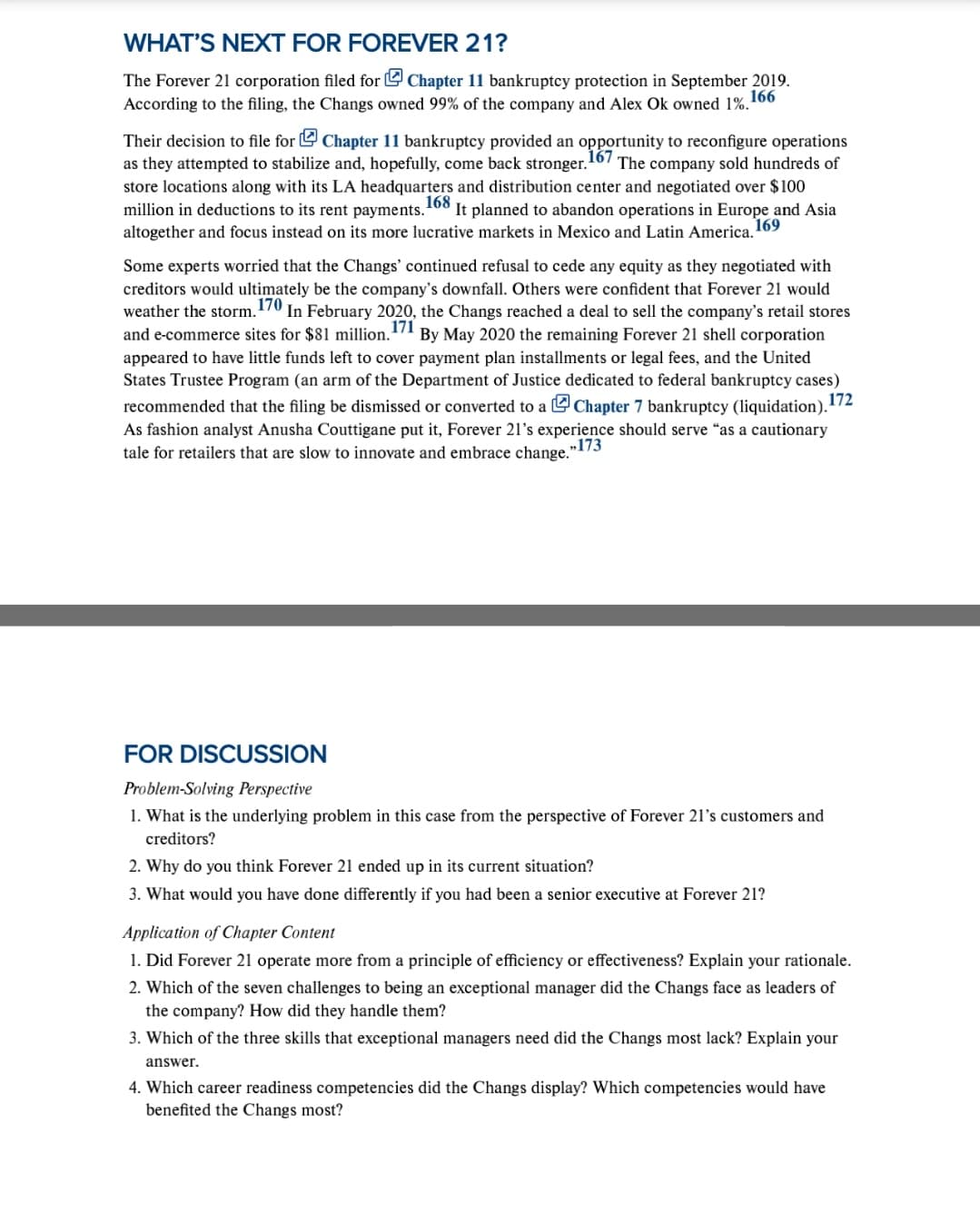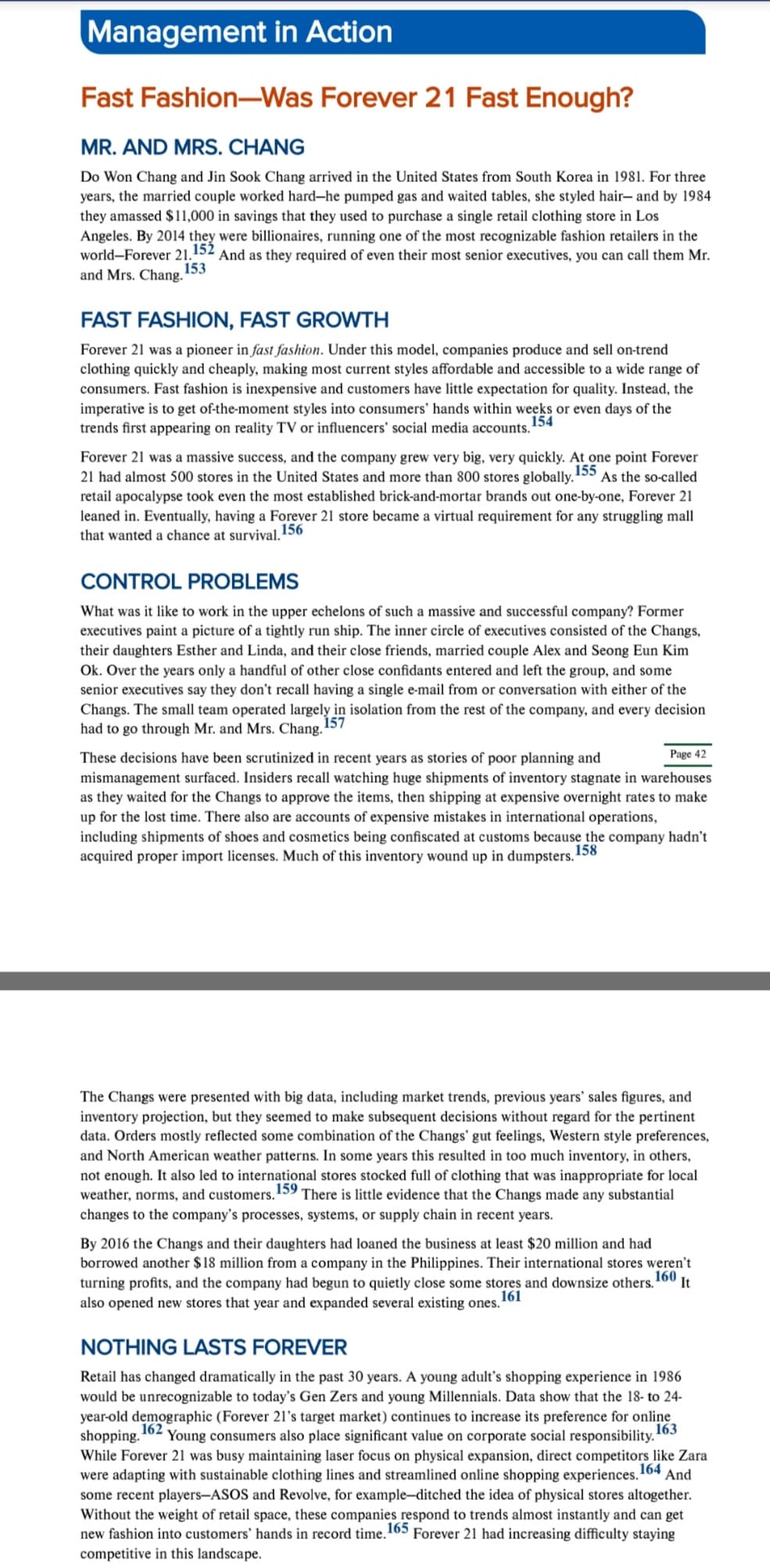Q1. What is the underlying problem in this case from the perspective of Forever 21’s customers and creditors? Q2. Why do you think Forever 21 ended up in this situation? Q3. Did Forever 21 operate more from a principle of efficiency or effectiveness? Explain your rationale.
Q1. What is the underlying problem in this case from the perspective of Forever 21’s customers and creditors? Q2. Why do you think Forever 21 ended up in this situation? Q3. Did Forever 21 operate more from a principle of efficiency or effectiveness? Explain your rationale.
Management, Loose-Leaf Version
13th Edition
ISBN:9781305969308
Author:Richard L. Daft
Publisher:Richard L. Daft
Chapter3: The Environment And Corporate Culture
Section: Chapter Questions
Problem 1ED
Related questions
Question
Q1. What is the underlying problem in this case from the perspective of Forever 21’s customers and creditors?
Q2. Why do you think Forever 21 ended up in this situation?
Q3. Did Forever 21 operate more from a principle of efficiency or effectiveness? Explain your rationale.
Q4. Which of the three skills that exceptional managers need did the Changs most lack? Explain your answer.
Q5. What would you have done differently if you had been a senior executive at Forever 21?

Transcribed Image Text:WHAT'S NEXT FOR FOREVER 21?
The Forever 21 corporation filed for U Chapter 11 bankruptcy protection in September 2019.
According to the filing, the Changs owned 99% of the company and Alex Ok owned 1%.166
Their decision to file for Chapter 11 bankruptcy provided an opportunity to reconfigure operations
as they attempted to stabilize and, hopefully, come back stronger. 16/ The company sold hundreds of
store locations along with its LA headquarters and distribution center and negotiated over $100
million in deductions to its rent payments.
168
It planned to abandon operations in Europe and Asia
169
altogether and focus instead on its more lucrative markets in Mexico and Latin America.
Some experts worried that the Changs' continued refusal to cede any equity as they negotiated with
creditors would ultimately be the company's downfall. Others were confident that Forever 21 would
weather the storm.170 In February 2020, the Changs reached a deal to sell the company's retail stores
and e-commerce sites for $81 million.
appeared to have little funds left to cover payment plan installments or legal fees, and the United
States Trustee Program (an arm of the Department of Justice dedicated to federal bankruptcy cases)
By May 2020 the remaining Forever 21 shell corporation
172
recommended that the filing be dismissed or converted to a L Chapter 7 bankruptcy (liquidation).
As fashion analyst Anusha Couttigane put it, Forever 21's experience should serve "as a cautionary
tale for retailers that are slow to innovate and embrace change."
„173
FOR DISCUSSION
Problem-Solving Perspective
1. What is the underlying problem in this case from the perspective of Forever 21's customers and
creditors?
2. Why do you think Forever 21 ended up in its current situation?
3. What would you have done differently if you had been a senior executive at Forever 21?
Application of Chapter Content
1. Did Forever 21 operate more from a principle of efficiency or effectiveness? Explain your rationale.
2. Which of the seven challenges to being an exceptional manager did the Changs face as leaders of
the company? How did they handle them?
3. Which of the three skills that exceptional managers need did the Changs most lack? Explain your
answer.
4. Which career readiness competencies did the Changs display? Which competencies would have
benefited the Changs most?

Transcribed Image Text:Management in Action
Fast Fashion-Was Forever 21 Fast Enough?
MR. AND MRS. CHANG
Do Won Chang and Jin Sook Chang arrived in the United States from South Korea in 1981. For three
years, the married couple worked hard-he pumped gas and waited tables, she styled hair- and by 1984
they amassed $11,000 in savings that they used to purchase a single retail clothing store in Los
Angeles. By 2014 they were billionaires, running one of the most recognizable fashion retailers in the
world-Forever 21.152 And as they required of even their most senior executives, you can call them Mr.
153
and Mrs. Chang.
FAST FASHION, FAST GROWTH
Forever 21 was a pioneer in fast fashion. Under this model, companies produce and sell on-trend
clothing quickly and cheaply, making most current styles affordable and accessible to a wide range of
consumers. Fast fashion is inexpensive and customers have little expectation for quality. Instead, the
imperative is to get of-the-moment styles into consumers' hands within weeks or even days of the
trends first appearing on reality TV or influencers' social media accounts. 154
Forever 21 was a massive success, and the company grew very big, very quickly. At one point Forever
21 had almost 500 stores in the United States and more than 800 stores globally.
retail apocalypse took even the most established brick-and-mortar brands out one-by-one, Forever 21
leaned in. Eventually, having a Forever 21 store became a virtual requirement for any struggling mall
that wanted a chance at survival. 156
155
As the so-called
CONTROL PROBLEMS
What was it like to work in the upper echelons of such a massive and successful company? Former
executives paint a picture of a tightly run ship. The inner circle of executives consisted of the Changs,
their daughters Esther and Linda, and their close friends, married couple Alex and Seong Eun Kim
Ok. Over the years only a handful of other close confidants entered and left the group, and some
senior executives say they don't recall having a single e-mail from or conversation with either of the
Changs. The small team operated largely in isolation from the rest of the company, and every decision
had to go through Mr. and Mrs. Chang.
157
These decisions have been scrutinized in recent years as stories of poor planning and
Page 42
mismanagement surfaced. Insiders recall watching huge shipments of inventory stagnate in warehouses
as they waited for the Changs to approve the items, then shipping at expensive overnight rates to make
up for the lost time. There also are accounts of expensive mistakes in international operations,
including shipments of shoes and cosmetics being confiscated at customs because the company hadn't
acquired proper import licenses. Much of this inventory wound up in dumpsters. 158
The Changs were presented with big data, including market trends, previous years' sales figures, and
inventory projection, but they seemed to make subsequent decisions without regard for the pertinent
data. Orders mostly reflected some combination of the Changs' gut feelings, Western style preferences,
and North American weather patterns. In some years this resulted in too much inventory, in others,
not enough. It also led to international stores stocked full of clothing that was inappropriate for local
There is little evidence that the Changs made any substantial
159
weather, norms, and customers.
changes to the company's processes, systems, or supply chain in recent years.
By 2016 the Changs and their daughters had loaned the business at least $20 million and had
borrowed another $18 million from a company in the Philippines. Their international stores weren't
160
turning profits, and the company had begun to quietly close some stores and downsize others.
It
also opened new stores that year and expanded several existing ones.101
NOTHING LASTS FOREVER
Retail has changed dramatically in the past 30 years. A young adult's shopping experience in 1986
would be unrecognizable to today's Gen Zers and young Millennials. Data show that the 18- to 24-
year-old demographic (Forever 21's target market) continues to increase its preference for online
shopping. 162 Young consumers also place significant value on corporate social responsibility. 163
While Forever 21 was busy maintaining laser focus on physical expansion, direct competitors like Zara
were adapting with sustainable clothing lines and streamlined online shopping experiences.
164
And
some recent players-ASOS and Revolve, for example-ditched the idea of physical stores altogether.
Without the weight of retail space, these companies respond to trends almost instantly and can get
new fashion into customers' hands in record time.165 Forever 21 had increasing difficulty staying
competitive in this landscape.
Expert Solution
This question has been solved!
Explore an expertly crafted, step-by-step solution for a thorough understanding of key concepts.
This is a popular solution!
Trending now
This is a popular solution!
Step by step
Solved in 5 steps

Follow-up Questions
Read through expert solutions to related follow-up questions below.
Follow-up Question
Can you please answer the rest of the question
Solution
Recommended textbooks for you

Management, Loose-Leaf Version
Management
ISBN:
9781305969308
Author:
Richard L. Daft
Publisher:
South-Western College Pub


Management, Loose-Leaf Version
Management
ISBN:
9781305969308
Author:
Richard L. Daft
Publisher:
South-Western College Pub
